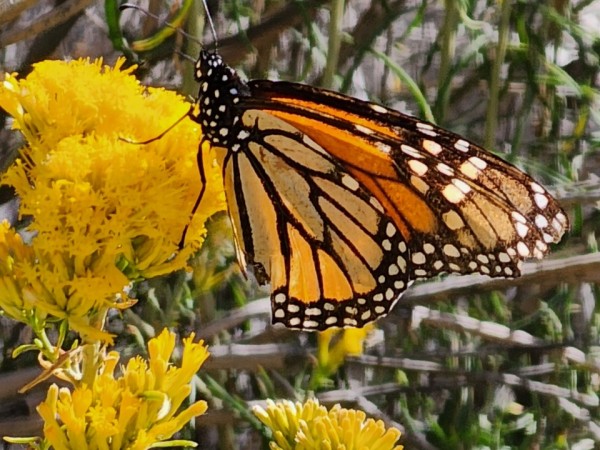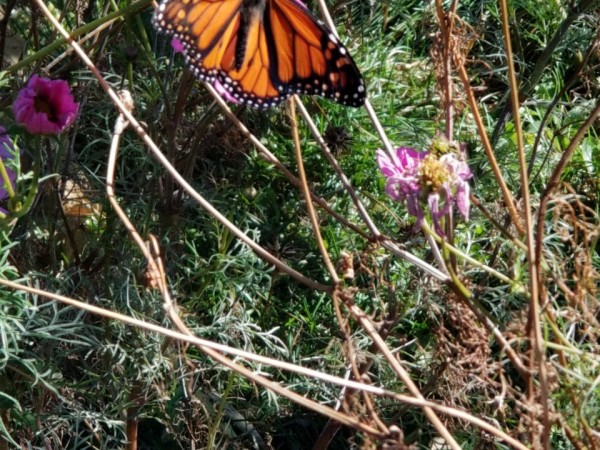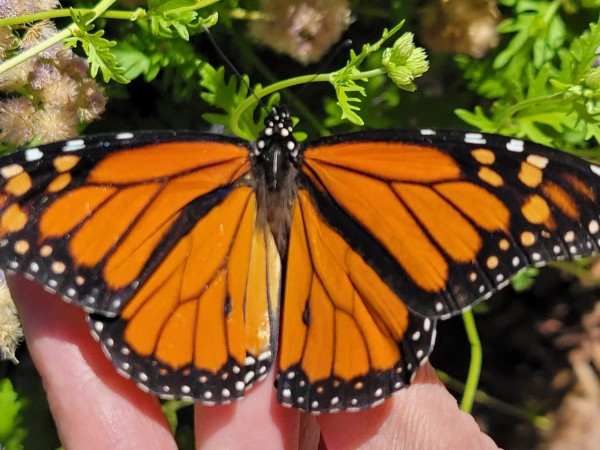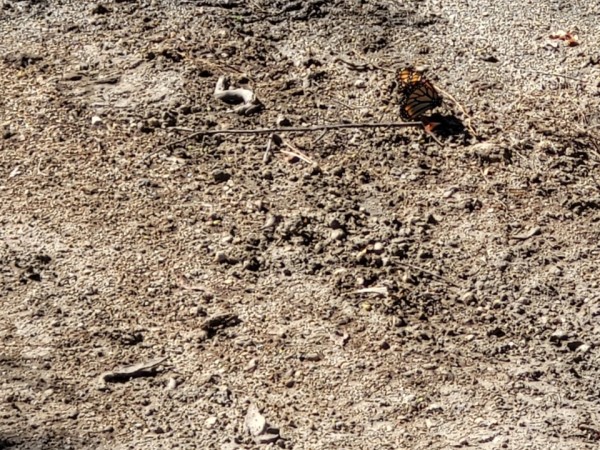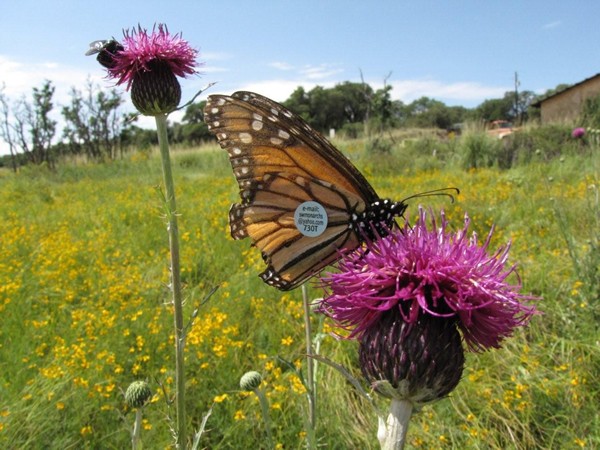Letter From Gail Morris: Western Monarch Fall 2023 Report #4
published: 10/25/2023
Western Monarchs Update
Monarchs are hurrying to their winter destinations with cooler weather on the way. All new sightings this week were only from Nevada, Utah, California, and Arizona. Meanwhile, numbers along the California coast are beginning to swell as more monarchs arrive each day. Field reports indicate fewer monarchs than last year but still growing. Meanwhile, the peak migration moves to the southern latitudes into the greater Phoenix area and to the border. What will monarchs in southern California do for the winter?
Monarch Sightings
Here are samples of recent monarch sightings. Be sure to check out Journey North's live maps of monarch sightings to see where monarchs are now near you!
Jenna reported one monarch in Alamo, Nevada, on October 15. “Pahranagat NWR. Monarch flitting among the rabbitbrush. A pleasant surprise after the eclipse.”
Martina in Ogden, Utah spotted a monarch on October 18. “Monarch sighted. 15 Celsius. Sunny.”
On October 21, Diana found one monarch in Tucson, Arizona. “Wild male monarch captured and tagged while nectaring on Gregg's mistflower. In Tucson, AZ backyard monarch waystation.”
Erin in Bishop, California, found one monarch. “At 8:30 am it was 58 degrees and there was a light breeze. An adult Monarch was flushed from a riparian area that had blooming rubber rabbitbrush nearby. It appeared to be in good shape. The Monarch flew off to the north. There were two additional sightings of Monarchs farther west up the riparian corridor; however, I could not confirm if these were two different individuals. Upon returning to the same area at noon, a Monarch was seen in the same area as before. At this time, it was 68 degrees and no wind.”
Reports from the Field
Pacific Grove, California:
Stephanie Turcotte sends her weekly report of the season from the Pacific Grove Monarch Sanctuary.
“We just finished our count in Pacific Grove this morning. It was already 58 degrees inside the grove at sunrise. Pacific Grove experienced an array of weather patterns since the last count, even within a particular day. We had some high temps and fog all rolled into one. The monarchs are still spread amongst 16-17 trees; however, they are mostly on the Eucalyptus now and inside the grove as opposed to the fence line in the neighbors’ yards on the east and south sides. They are utilizing two Monterey pines, but only lightly. And there are only a few loners on any given Cypress. We had to hunt for them carefully and found them concentrated in the south and southwest. There is some rain predicted on Sunday and perhaps they have positioned themselves for that. It certainly feels like rain in the grove.
“What is always such a lovely surprise, while looking through the binoculars, is to discover monarchs strewn on a leafless branch and wedged between and inside the lace lichen. A less enjoyable surprise is when a beautiful warbler disturbs a cluster, mid-count, and about 10 fly off! :-)
“So, last week we counted 704 and our count today, 10/20/23 is 1,788! For those of you who are curious, in 2021, we had 2,593 on 10/21/21 and we had 3,823 on 10/21/22. (And no tagged monarchs seen as of yet.)”
Santa Cruz, California:
Diana Magor shares her observations and photos from Lighthouse Field in Santa Cruz.
“I did a survey this am [10/20/2023] at Lighthouse Filed and counted 2,520 monarchs. All were roosting with wings closed on Cypress trees, the majority deep inside the grove. Virtually none were sunning or flying. It was a cool, foggy, calm morning. Some seemed smaller to me than migrants from past years. [Diana reported approximately 2,500 monarchs last year on 10/20/22.]
“Lots of monarchs in and around town! I have seen a few mating and ovipositing in my garden, and one egg laid on the flower clusters of one of my test Heartleaf milkweeds hatched a few days ago. It nipped the pedicel of the bud it was on (as you know, monarchs do that to reduce the flow of latex to the leaf or bud they intend to consume). Sadly it was gone the day after I took the photo, and I found a spider under the remains of the bud 😢.”
Greater Phoenix, Arizona area:
The peak migration was about 10 days late this year, likely due to record temperatures in the region. But finally, a gateway of a cooler airflow opened and soared the monarchs into Phoenix! At first, there was a trickle but it took everyone’s breadth away when they appeared. Georgette and her children were hiking along the Agua Fria River when they spotted a large number of Queen butterflies on one side of a trail filled with Desert Broom shrubs. Curious, she walked around to the east side of the Desert Broom and found 8 to 10 monarchs! It was difficult to be precise in number since they were flying from shrub to shrub. But what a delight to see so many at once! “I’m currently a student with an end goal of a PhD in wildlife ecology & conservation and this is so important to me.” (See Georgette’s photo of one visiting a Desert Broom shrub north of the Phoenix area.)
Yesterday Angela went out looking for monarchs in her neighborhood in Goodyear not too far from the Agua Fria River south of Phoenix. Her gated community has landscaping designed to draw native pollinators and is filled with Desert (Rush) Milkweed, Ascelpias subulata, and other monarch favorites. After days of searching, she hit the jackpot with over 10 large, bright orange monarchs feeding voraciously on the milkweed flowers! (Be sure to watch her Facebook video.)
A special Thank You to Stephanie and Diana for their reports!
Needed: Your Reports!
Where are monarchs in the West? Please send in your reports of monarchs you are seeing in any life stage. Provide as much information as you can such as weather conditions (it’s okay to estimate), wing condition (excellent to frayed and everything in between), monarch gender, or flight direction. We look forward to hearing from you!
Gail Morris is the Coordinator of the Southwest Monarch Study (www.swmonarchs.org), a Monarch Watch Conservation Specialist, and the Vice President of the Monarch Butterfly Fund, the Central Arizona Butterfly Association, and the Western Monarch Advocates. The Western Monarch Population News is based on comments provided to Gail Morris. We hope to increase the number of sightings and therefore photos and comments entered into the Journey North. We rely on the volunteers who communicate regularly with Gail and who agree to participate in our effort to increase awareness of the population of Western Monarchs. You can reach her at gail@swmonarchs.org

